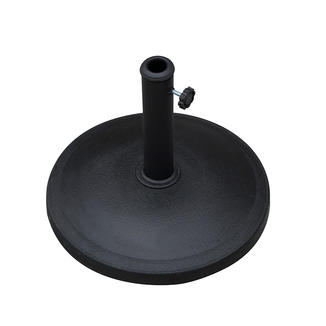In areas with frequent strong winds, an overturned patio umbrella will not only ruin the pleasant outdoor time, but also may bring safety hazards. To choose a truly wind-resistant and durable patio umbrella, you need to go beyond the thinking of "appearance first" and consider professional dimensions such as material mechanics, structural design and climate adaptability.
1. Material selection: the underlying logic of wind resistance
The durability of windproof umbrellas starts with materials. The rib material must meet the contradictory needs of lightweight and high strength at the same time:
Aviation-grade aluminum alloy (such as 6061-T6 model) can withstand strong wind impact without deformation with an elastic modulus of 8.5GPa, and is more than 60% lighter than traditional steel.
Glass fiber reinforced resin ribs absorb vibration energy through the damping effect of composite materials to avoid metal fatigue fracture.
Be wary of cheap iron umbrella poles-the tensile strength is only 350MPa, far lower than the 570MPa of aluminum alloy, and it is easy to rust and cause structural embrittlement.
The fabric of the umbrella surface needs to have both tear resistance and low wind resistance:
The warp and weft of high-density polyester fiber (such as 600D specifications) adopts a double-twisted process, and the tear strength can reach more than 45N, far exceeding the 28N of ordinary acrylic fabrics.
Hydrophobic coatings (such as Teflon treatment) can reduce the risk of tipping caused by the weight gain of rainwater, while improving the UV resistance to UPF50+.
2. Structural design: Windproof wisdom of engineering mechanics
Excellent structural design can disperse and transmit wind loads to avoid damage caused by stress concentration:
Double-top ventilation system: The double-layer umbrella top structure designed by bionics has a top opening rate of 15%-20% (such as the Abaco Patio series), which can release more than 50% of the wind pressure. Its principle is similar to the wind vent of a kite.
Tilted rib angle: The ribs are 7-10° outwardly tilted with the central axis (such as the Sunbrella Ventura model), forming a tension structure similar to a suspension bridge, and the wind resistance is 3 times higher than that of the straight arm design.
Gravity anchor base: According to the fluid mechanics formula F=0.5×ρ×v²×A, a 3m diameter umbrella needs at least 80kg weight when the wind speed is 8m/s. Concrete base or water-filled base (volume must reach more than 300L) is recommended.
III. Functional verification: hard-core testing beyond marketing rhetoric
In the face of the "super wind resistance" label claimed by merchants, it is recommended to verify through three dimensions:
ASTM certification: Umbrellas tested by ASTM F1977-19 standard can maintain structural integrity under instantaneous wind speed of 13.4m/s (level 6 wind).
Dynamic load test: High-quality products will simulate reciprocating swings at a frequency of 20Hz (similar to wind tower vibration test) to ensure that the hinge mechanism is not loose after 5000 cycles.
User scenario verification: Refer to the long-term use feedback of users in coastal areas (such as Florida and Qingdao). Real environment data is more valuable than laboratory tests.
4. Maintenance strategy: the key to extending the life of windproof umbrellas
Wind resistance will decay over time, so scientific maintenance is essential:
Quarterly inspection: Use a torque wrench to calibrate the rib joints (recommended torque value 4.5N·m) to prevent bolt loosening from causing resonance effects.
Seasonal storage: Tilt the umbrella at 45° in winter to prevent snow loads exceeding the design value (usually ≤50kg/m²).
Fabric maintenance: Treat the umbrella surface with a pH-neutral detergent every quarter to prevent mildew from corroding the fiber structure.

 English
English España
España EN
EN ES
ES











